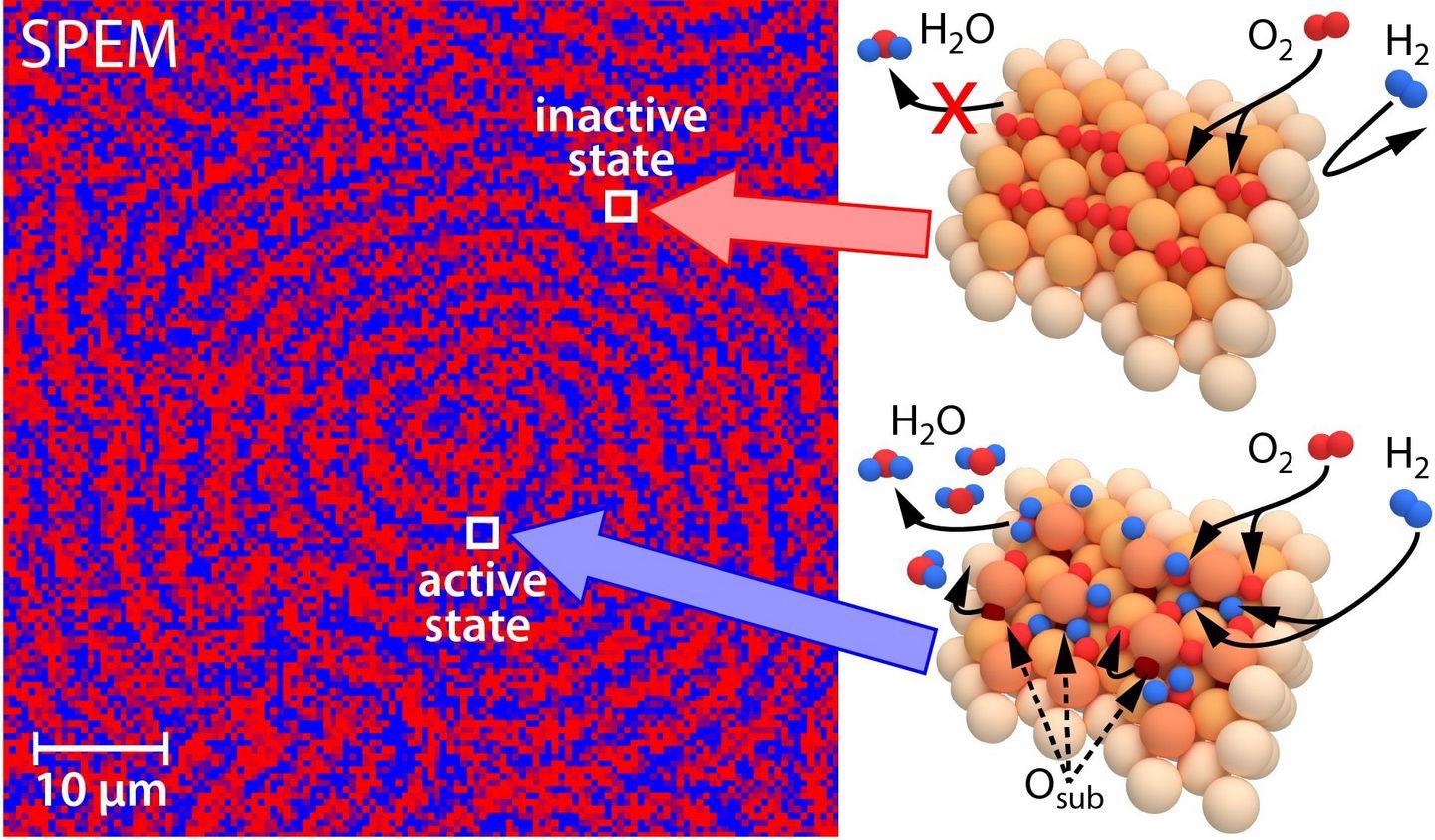Occasionally, chemical reactions in the lab turn out the way one imagines them to, and from time to time they do not. Neither is uncommon. What is very rare, however, is what researchers at TU Wien have recently observed when investigating hydrogen oxidation on a rhodium catalyst.
 Local pattern formation in oscillatory hydrogen oxidation on rhodium: a scanning photoelectron microscope (SPEM) was used to create a chemical map of the species on the catalyst surface (left). Spectroscopic data (XPS) of the surface coverage enable the development of atomic models of the associated surface activity states (right). (Image Credit: TU Wien).
Local pattern formation in oscillatory hydrogen oxidation on rhodium: a scanning photoelectron microscope (SPEM) was used to create a chemical map of the species on the catalyst surface (left). Spectroscopic data (XPS) of the surface coverage enable the development of atomic models of the associated surface activity states (right). (Image Credit: TU Wien).
The team observed that the surface of a rhodium foil can be extremely chemically active in certain surface regions, while in others, just a few micrometers away, it is totally inactive, and still in others oscillations between the inactive and active state take place. Such behavior was formerly believed to be nearly unthinkable.
The results, which have recently been published in the scientific journal "Nature Communications", demonstrate that catalysis is more complex than formerly thought.
Basic Principle of the Fuel Cell
With the help of catalysts such as metallic rhodium, hydrogen can be oxidized - this is the basic reaction in fuel cells, with only water being produced as ‘waste gas’.
Prof. Yuri Suchorski, Institute of Materials Chemistry, TU Vienna
Hydrogen molecules are held on the rhodium surface and divided into separate atoms, which then unite with oxygen to create water.
However, sometimes a layer of oxygen completely covers the rhodium surface, such that the hydrogen is unable to reach the rhodium atoms at all.
In this case, the surface of the catalyst is said to be poisoned. The catalyst can no longer fulfill its function, the reaction comes to a standstill.
Prof. Günther Rupprechter, Project Lead, Institute of Materials Chemistry, TU Vienna
Whether the catalyst performs its task or is poisoned is based on external parameters, such as a reactant’s pressures and temperature. But the rhodium foil displays an odd behavior in the experiment.
Although all areas of the surface experience the same external settings, certain areas tend to be catalytically active, others poisoned and totally inactive, and still others shift back and forth between an active state and an inactive state with varying frequencies.
"This sounds so unusual that until now we couldn't even imagine that such a thing was possible," says Philipp Winkler, the study’s first author.
Closer scrutiny, which the TU Vienna researchers performed at the Elettra Synchrotron in Trieste along with Italian colleagues, helped them to explain the observations. The polycrystalline rhodium surface is made up of various grains aligned at different angles. This means that the alignment of atoms on the surface varies from grain to grain.
Prof. Yuri Suchorski stated that "The dynamics of the chemical reaction is surprisingly sensitive to the orientation of the grains and thus to the atomic structure of the surface.”
In case of rhodium, the differences between the catalytic properties of individual structures are much larger than expected, and so it is possible for different grains to behave completely differently at the same time and under the same conditions. Here, the oscillatory behavior is particularly interesting.
Prof. Yuri Suchorski, Institute of Materials Chemistry, TU Vienna
Rabbits and Foxes
Comparable processes are seen in very different areas of science — for example, from predator-prey models: If the number of rabbits born is high, foxes have a lot to eat, then the following year, more hungry foxes are born and the number of rabbits drops.
Similar to rabbits and foxes, the interaction of hydrogen and oxygen is a process that is in dynamic equilibrium or can vacillate between various states. Even if the number of rabbits and foxes are primarily the same everywhere, quite diverse temporal developments may happen in different places — for example, rabbits could hide better from foxes in some places than somewhere else.
Likewise, the varied chemical dynamics arise on diverse grains of the rhodium surface.
These outcomes offer a vital insight that has great implications for catalysis research on the whole: it is not sufficient to define a catalyst universally; one has to consider its local microscopic structure and estimate the fact that it can display quite different behavior at various sites.
We are sure that such effects are significant for many different catalysts and reactions. In any case, there is still a lot to do in this field of research.
Prof. Günther Rupprechter, Project Lead, Institute of Materials Chemistry, TU Vienna
The study was funded by the Austrian Science Fund (FWF) within Project “Spatial-temporal phenomena on surface structure libraries.”
Journal Reference:
Winkler, P., et al. (2021) Coexisting multi-states in catalytic hydrogen oxidation on rhodium. Nature Communications. doi.org/10.1038/s41467-021-26855-y.